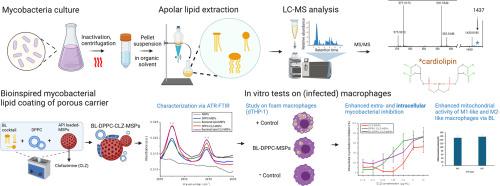生物启发分枝杆菌脂质涂层多孔颗粒增强抗菌功效。
IF 4.7
3区 医学
Q1 PHARMACOLOGY & PHARMACY
引用次数: 0
摘要
本研究旨在探讨牛分枝杆菌卡介苗独特的脂质组成及其增强脂质包被介孔二氧化硅颗粒(MSPs)抗菌效果的潜力。用石油醚提取细菌脂质(BL),通过LC-MS分析,发现含有心磷脂、磷脂酰胆碱、磷脂酰乙醇胺和三酰基甘油等复杂的磷脂混合物。以细菌脂质和肺表面活性物质DPPC为主要成分,通过囊泡融合法对MSPs进行脂质包被,并用ATR-FTIR光谱进行验证。以氯法齐明(CLZ)作为结核的药物模型。与未包被和dppc包被的CLZ-MSPs相比,获得的bl - dppc包被的CLZ-MSPs在抑制分枝杆菌生长和杀死细胞内分枝杆菌方面更有效。细菌脂质对m1样和m2样人原代巨噬细胞具有良好的安全性,不会引起强烈的免疫反应或形成泡沫细胞。这些结果表明,所获得的细菌脂质包被可以提高直接治疗肺细胞外和细胞内分枝杆菌感染的抗菌效果。本文章由计算机程序翻译,如有差异,请以英文原文为准。

Bioinspired mycobacterial lipid coating of porous particles for enhanced antimicrobial efficacy
The study aimed to investigate the unique lipid composition of Mycobacterium bovis BCG and its potential to enhance antimicrobial efficacy of lipid-coated mesoporous silica particles (MSPs). The bacterial lipids (BL) were extracted with petroleum ether and analyzed via LC-MS, revealing a complex mixture of phospholipids, including cardiolipin, phosphatidylcholine, phosphatidylethanolamine, and triacylglycerols. Lipid coating (using bacterial lipids and lung surfactant DPPC as the main component) was performed on MSPs via vesicle fusion approach and confirmed with ATR-FTIR spectroscopy. MSPs were loaded with clofazimine (CLZ), as a drug model for tuberculosis. The obtained BL-DPPC-coated CLZ-MSPs were more effective in inhibiting mycobacterial growth and killing intracellular mycobacteria compared to uncoated and DPPC-coated CLZ-MSPs. The bacterial lipids showed a good safety profile on M1-like and M2-like human primary macrophages without inducing a strong immune response or formation of foam cells. These findings suggest that the obtained bacterial lipid coatings can improve antimicrobial efficacy in treating both extracellular and intracellular mycobacteria infections directly in the lungs.
求助全文
通过发布文献求助,成功后即可免费获取论文全文。
去求助
来源期刊
CiteScore
9.60
自引率
2.20%
发文量
248
审稿时长
50 days
期刊介绍:
The journal publishes research articles, review articles and scientific commentaries on all aspects of the pharmaceutical sciences with emphasis on conceptual novelty and scientific quality. The Editors welcome articles in this multidisciplinary field, with a focus on topics relevant for drug discovery and development.
More specifically, the Journal publishes reports on medicinal chemistry, pharmacology, drug absorption and metabolism, pharmacokinetics and pharmacodynamics, pharmaceutical and biomedical analysis, drug delivery (including gene delivery), drug targeting, pharmaceutical technology, pharmaceutical biotechnology and clinical drug evaluation. The journal will typically not give priority to manuscripts focusing primarily on organic synthesis, natural products, adaptation of analytical approaches, or discussions pertaining to drug policy making.
Scientific commentaries and review articles are generally by invitation only or by consent of the Editors. Proceedings of scientific meetings may be published as special issues or supplements to the Journal.

 求助内容:
求助内容: 应助结果提醒方式:
应助结果提醒方式:


